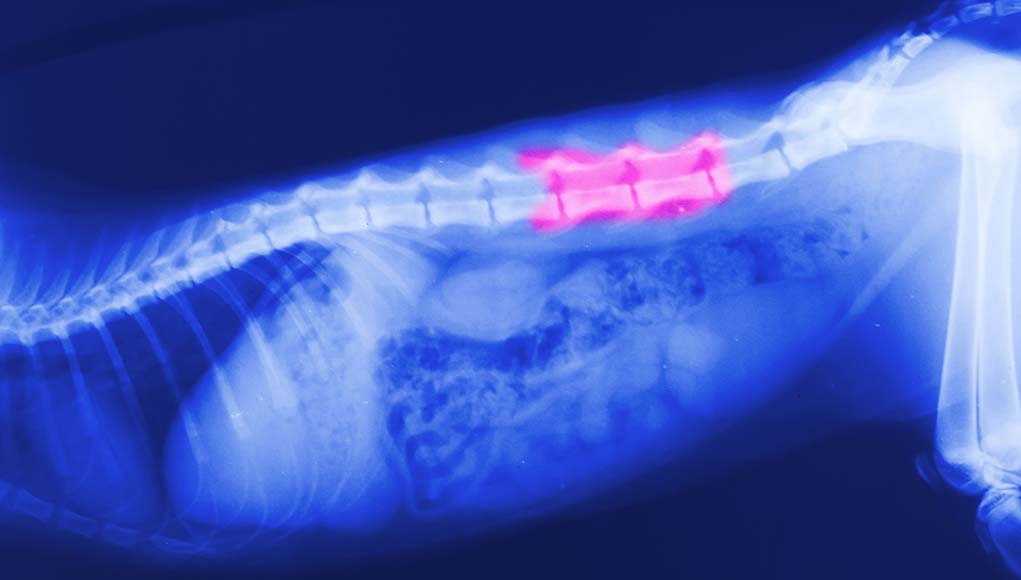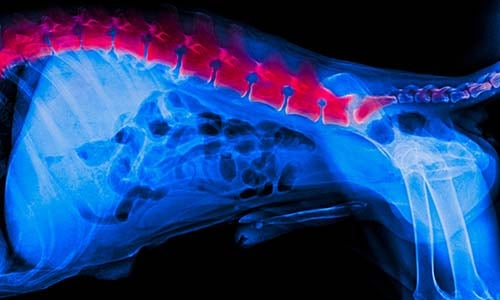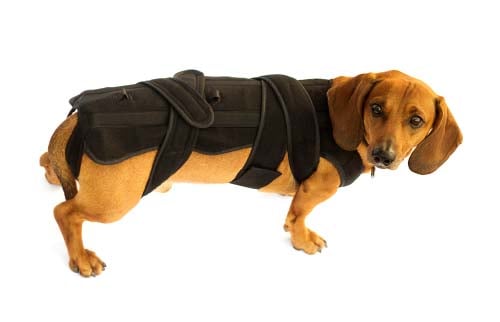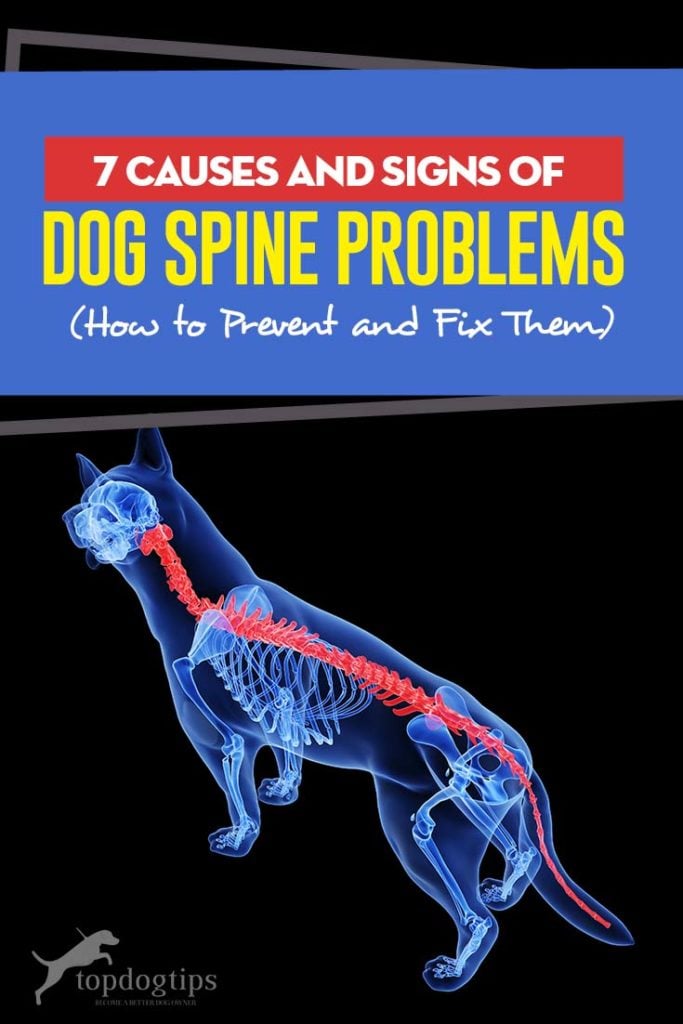Table of Contents
- Common Signs of Dog Spine Problems
- Causes of Dog Spine Problems
- 1. Trauma or Injury
- 2. Inflammatory and Infectious Diseases
- 3. Degenerative Myelopathy
- 4. Intervertebral Disc Disease (IVDD)
- 5. Lumbosacral Stenosis
- 6. Spondylosis
- 7. Tumors
- Dog Spine Problems: FAQs
- How do you know if your dog has a spinal problem?
- Can a dog's spine heal on its own?
- Is a spinal infection life-threatening?
- What causes spinal problems in dogs?
- How long can a dog live with Degenerative Disc Disease?
- Can a dog recover from spinal injury?
- Is it bad if you can feel your dog's spine?
- Can a dog walk with a slipped disc?
- What causes weakness in a dog's rear legs?
- How much does spine surgery cost for dogs?
- Dog Spine Problems: Before You Go
Dog spine problems are more common than most owners realize.
Typically, they take time to develop before the symptoms become apparent and the dog's behavior changes, but it can seriously impact its quality of life.
According to Whitney Phillips, an AVCA Certified Animal Chiropractor, preventing dog back issues before they arise is the best approach to address them.
That entails sustaining a healthy weight and diet and an active lifestyle with lots of exercise.
Below we'll look at the most common signs of dog spine problems and what you can do to prevent and fix these issues.

Common Signs of Dog Spine Problems
There are several types of spinal problems in dogs, and symptoms vary depending on the condition's cause and severity. Some of the most common signs are below.
Inability to Move Naturally
The easiest way to spot a spinal problem in your dog is by paying attention to your pet's posture and movements, like rear limb weakness and an indication of pain, and signs of “spinal stroke,” all of which you may notice when the dog has trouble climbing stairs or getting into a car.
The dog may also start to drag their rear legs, often accompanied by tail dropping and hunched back. Other signs include lying down or getting up, unwillingness to move or jump, and limping.
Signs of Pain
While some dog spine problems can be painless for the dog, they are mostly accompanied by some pain or stiffness in the dog’s back or neck.
When the pain becomes too intense, dogs usually cry out or vocalize their pain in other ways.
Neurological Problems
Neurological problems related to spine conditions in dogs include loss of balance and coordination, loss of muscle mass and muscle spasms over the dog’s back and neck, and complete muscle atrophy.
In more extreme cases, even the inability to feel pain or paralysis can occur.
Loss of bowel or bladder control, also called incontinence, can be another clear sign of dog spinal problems.
Other Symptoms
You may notice some changes in your dog’s behavior, such as the dog developing a more anxious behavior and becoming sensitive to movement and even noises, reduced activity level, and decreased appetite.
Rapid breathing and shivering can also suggest spinal problems, and stress levels in the dog can also be observed.
There are many potential causes of these canine spine problems. While some are neurological, others result from inflammation or are caused by viral, bacterial, and fungal infections.
Below are the most common causes of dog spine problems.
Causes of Dog Spine Problems
1. Trauma or Injury
The most common cause of spinal problems in dogs is trauma.
The trauma can be caused by a fall or an accident, although the more common causes include everyday activities like jumping for balls and terrible posture.
Spinal cord injuries mainly occur as a result of a spinal dislocation or fraction.
However, the injury doesn’t have to be recent. The origin of the spinal problem can happen years before symptoms show up.
Symptoms of spinal trauma in the dog usually show up suddenly and can be severe and worsen progressively.
How to Prevent It
There is no single way to prevent any kind of injury in dogs.
Keep your pup safe from traffic and cars since car accidents are one of the leading causes of injuries in dogs whenever playing or training with your dog, practice safety and be cautious.
Also, ensure that your pup has the correct posture and doesn’t work too hard during exercise or play.
Sometimes dogs do not realize when they're overworked, and you'll have to do this guesswork for them.
How to Fix It
If you notice that your canine is limping or show any other signs of spinal problems, take him to the vet immediately.
Your vet will notice any fractures or dislocations on X-rays or CT scans if the pet's problems are caused by trauma or injury.
The most common way to treat traumas in dogs is with pain medication and proper rest. However, some types of injuries require surgery.
2. Inflammatory and Infectious Diseases
Infectious and inflammatory diseases of the spine include viral, protozoal, fungal, bacterial, and parasitic infections and inflammation caused by unknown reasons.
Most of these diseases are neurological, which means they affect the dog’s brain.
Some of the more common conditions include canine distemper, rabies, rickettsial disease, and verminous myelitis.
How to Prevent It
Prevention of infectious diseases in dogs ensures that your puppy always has access to clean, fresh water and avoids getting in contact with infected animals.
Some dog bowls get dirty quicker and even carry bacteria, so pick those least likely to infect your pet (such as steel pet bowls).
If you're making homemade dog food recipes, always ensure that recipes are vet-approved and well-balanced and that the dog’s food is well-cooked.
Never let your dog go through the trash or eat things of unknown origin.
Vaccinations are the most effective way of preventing some of these diseases, like rabies and canine distemper.
How to Fix It
While some of these diseases in dogs can’t be treated or generally have a poor outlook, most are treated with antibiotics and other drugs, depending on the cause.
Fungal disease is treated with anti-fungal medicine.
Your vet is the only person to consult with and develop a treatment plan with.
3. Degenerative Myelopathy
The term degenerative myelopathy refers to the spinal cord or bone marrow disease in dogs.
It is a chronic, painless, degenerative disease with slow onset and no specific cause.
However, some dog breeds are more likely to suffer from it, like German Shepherds, Welsh Corgis, and Boxers.
Older dogs are more often affected than adult dogs or puppies (usually older than eight years).
Affected dogs suffer from degeneration of nerve fibers and the surrounding sheaths.
How to Prevent It
Since this condition is believed to be genetic and inherited, there is no way to prevent it without the known cause for its onset.
The only thing you can do is test your dog's DNA to determine if he's predisposed to this condition and then consult with a vet about the future.
How to Fix It
Unfortunately, supportive care is, at the moment, the only treatment option.
Exercise can help delay spinal cord atrophy in dogs, and you should avoid weight gain because it can increase pressure on the spine.
Sadly, dogs with this condition are usually euthanized within 1-3 years.
4. Intervertebral Disc Disease (IVDD)
Intervertebral disk disease (IVDD) is a term for degeneration and protrusion of the intervertebral disk in dogs, which leads to compression of the spinal cord and spinal nerve.
It is one of the most common causes of spinal problems in dogs.
This disease affects predominantly smaller breeds, like Dachshunds, Pekingese, Beagles, Basset Hounds, and Shih Tzu.
Of course, large breeds can also be affected, although it is usually characterized by later onset and slower progression compared to small species.
How to Prevent It
Dog breeds predisposed to this condition should always maintain a healthy weight to decrease the stress on the neck and backbone, which includes a quality diet and regular exercise.
When walking, using a good harness can help with it, especially if your dog often pulls on the leash.
How to Fix It
Treatment for IVDD in dogs will depend on the severity of it.
For example, dogs with minimal or moderate signs can recover with only a few weeks of rest.
They may also prescribe some anti-inflammatory or pain medication here.
Homeopathy can be helpful in some cases, but there's no clear scientific evidence one way or the other.
Pets that suffer from a more severe form of this disease often require surgery, especially if previously administered drug therapy doesn’t work.
Fortunately, chances of complete recovery after surgery are pretty good, especially in those cases where surgery is done before the dog loses the ability to feel pain.
5. Lumbosacral Stenosis
This spinal disorder affects the vertebrae in the lower back, which compresses the nerve roots as well.
Lumbosacral Stenosis in dogs is mainly seen in larger breeds, especially Boxers, German Shepherds, and Rottweilers. It is also more common in senior dogs.
While it is genetic in most cases, it can sometimes be caused by degenerative narrowing of the dog's spinal column.
This painful disease is often hard to diagnose, especially in older dogs, because the symptoms mimic other, more common conditions in old age.
How to Prevent It
Prevention of Lumbosacral Stenosis in dogs is hard to achieve.
One of the most important things is keeping your dog's weight at a healthy level and ensuring regular exercise.
How to Fix It
Dogs with mild pain are often prescribed pain medication in addition to a restricted exercise regime.
This should improve the dog’s condition in about 4-6 weeks.
For more severe cases, surgery is a standard option, usually combined with some drug therapy.
The prognosis after surgery is good, although some dogs may have problems with urinary incontinence.
6. Spondylosis
Spondylosis deformans, also commonly called spondylosis in dogs, is a degenerative condition that primarily affects the spine of senior pets.
It is characterized by degenerative disks that cause bone spurs to develop, forming bridges between one vertebra to another.
This can significantly limit the flexibility of a dog and its range of motion.
While the exact causes are unknown, it is believed that repetitive wear and stress of the bones and significant injuries lead to dog spondylosis.
In some cases, spondylosis is caused by genetic predisposition.
All breeds can suffer from spondylosis, although medium to large breeds like Boxers are particularly susceptible.
How to Prevent It
Since spondylosis is a relatively common occurrence in aging dogs, there are no known ways to prevent it at this moment.
How to Fix It
Spondylosis can often be a painless condition, and those cases don’t require any treatment.
In other cases, common treatments include pain medication, rest, and physical therapy.
Also, weight management is essential because it can reduce stress on the joints and spine.
Surgery is required in a small number of cases where bone spurs are causing compression of the spinal cord and have to be removed.
7. Tumors
Spinal tumors in dogs are not common, and over 90 percent of them occur in large breeds.
Some of the tumors attack the bones located on the vertebral column, while some affect the neural tissues in the spinal cord. These tumors are usually slow-growing.
How to Prevent It
While the exact causes of spinal tumors in dogs are often unknown, it is believed that you can decrease your pup's chances of getting it by keeping his weight in check and feeding him a high-quality, healthy diet.
How to Fix It
Depending on the exact location and type of tumor, common treatments include radiotherapy, chemotherapy, and surgery.
Palliative care is recommended to increase the quality of life in terminal cases.
Dog Spine Problems: FAQs
How do you know if your dog has a spinal problem?
An injured spinal column can make it difficult for the dog to move around normally.
He might object to standing and playing. He can stumble drunkenly rather than striding with ease.
You might also observe that your dog tends to drag or shuffle its hind legs.
Can a dog's spine heal on its own?
With at least 4 weeks of cage rest and pain treatment, a dog with spinal pain but no paralysis can be treated (recovery rates range from 22 to 52% in these cases).
If the spinal cord is only partially damaged, dogs can recover well from their injuries because the remaining nerves can perform the functions of the lost ones.
Is a spinal infection life-threatening?
Three areas of the spine are susceptible to infection: the spinal discs, the spine bone, and the spinal canal.
The most serious infection occurs in the spinal canal, and if it is not identified and treated right once, it can cause paralysis or death within 48–72 hours.
What causes spinal problems in dogs?
There are several potential causes of disc ruptures, a herniated disc, abnormal posture, or other issues with the spine.
A severe injury is one possible cause. Your dog may also have a congenital disability or a degenerative disease.
He may have an infectious or inflammatory disease causing the issues.
Other potential causes include nutritional diseases, tumors, toxic disorders, or vascular diseases.
Expect your vet to use diagnostic imaging such as X-rays and computed tomography (CT) scans to discover the cause of your dog's condition.
How long can a dog live with Degenerative Disc Disease?
How long your dog can live with degenerative disc disease depends on how severely affected he is and how you feel about his quality of life.
With the proper early treatment, he may have a long and whole life.
However, you will likely have to deal with symptoms as he ages.
Most dogs that develop this disease are about three to seven years old.
Can a dog recover from spinal injury?
If your dog is seriously injured, such as in a road traffic accident, you may wonder about his potential recovery.
The critical thing to remember is that tissue in the spinal cord will not regenerate quickly.
This means that he may need extensive surgical treatment to recover. Even after surgery, he may have issues.
These can include partial paralysis or problems with your dog's muscles.
If your dog only has partial damage, however, the outcome is much better.
The undamaged nerves in the spinal cord can take over. They will eventually handle the functions of the lost nerves.
Of course, it takes time for the nervous system to make this change, and your dog will need other treatments to help.
Is it bad if you can feel your dog's spine?
No, it is entirely normal to feel your dog's spine. However, it should not be very pronounced. This can indicate your dog is underweight.
Can a dog walk with a slipped disc?
Yes, a dog can walk with a slipped disc.
However, he may need pain medications, and your vet may still recommend spinal surgery.
In many cases, your dog may not even need surgery.
Among dogs with feeling in the affected limbs, 80% with paralyzed or weak back legs can recover without surgery.
The important caveat is that they will need up to 12 weeks before being able to walk.
You should never force your dog to walk if you suspect partial or complete paralysis.
If you aren't sure about his physical abilities, consult your doctor of veterinary medicine.
They can tell you the prognosis and give you tips to overcome muscle weakness and other challenges.
It is also essential to account for your dog's pain sensation as he heals and begins walking.
He may need medicine to help with severe pain before being willing to walk.
What causes weakness in a dog's rear legs?
There are several possible causes of weak rear legs. Degenerative myelopathy is one of these.
This condition starts affecting the rear legs.
It leads to poor coordination, muscle loss, and muscle weakness.
If your dog has weak hind legs, your vet will give him a physical exam and run diagnostic tests to find the cause.
Instead of focusing on the hind limbs, he will examine all four legs.
He may also apply gentle pressure on the spinal area to feel for issues or gauge your dog's pain levels.
The vet may use magnetic resonance imaging (MRI).
He will likely want to check for disc degeneration, spinal cord dysfunction, disc rupture, disc extrusion, spinal cord compression, or intervertebral disc disease.
He will also check the condition of your dog's spinal nerves and look for any other severe signs of issues.
How much does spine surgery cost for dogs?
The cost of surgery and diagnostic imaging will depend on the specific condition being treated. It will also depend on where you live.
Expect to pay between $1,000 and $3,000 for imaging like X-rays and magnetic resonance imaging.
You can quickly pay between $1,500 and $4,000 for the surgery itself. Emergency surgery typically costs more than planned surgery.
Dog Spine Problems: Before You Go
Spine problems in dogs are relatively common, especially as pets grow old.
Some of the common symptoms of spine problems include pain and stiffness in the back and neck, loss of mobility, limpness, and bad posture.
Treatment options will depend on the exact cause of dog spine problems and the specific issue.
They typically range from simple weight management, restricted training regime, and proper rest to administering various medicine and, at the final stage, surgery.
READ NEXT:
- 6 Signs of Back Problems in Dogs and What You Can Do About It
- Found Crusty Scabs on Dog's Back? Here’s Why and What to Do
- 8 Vet's Tips on How to Care for Senior Dogs





















